February 16 Fishing Report
What a story we had yesterday, as we took two of our clients out on a day of fly fishing. They have fished all over Florida, but have yet to experience the might and power of a billfish. Within 15 minutes of getting to the fishing grounds and getting the lines out, we see a 300+ pound marlin come ripping through the teasers. As he comes toward the boat, we get our fly out right by him, he sees it, makes a lightning fast turn, lights up in a beautiful fluorescent display, and he crushes it only like a blue marlin can. That was at around 9:15 in the morning. At around 5:00 PM, that fish was still going strong. Our client learned that these fish fight long and hard, and will never give up. After many spectacular jumps and who knows how many furious runs he made, we had to let that fish go. Tomorrow we are going after sails, my client is a bit too tired for another 7+ hour fight with a blue marlin. Let it be known that with more experience and practice, these fish can be landed in a shorter time period, but I guess we learned our lesson! Please visit us at DRSportfishingcostarica.com and take your shot at these remarkable fish down in Costa Rica.
Sport Fishing Forums – Offshore Big Game Fishing News Click Here
——-
BASTILLE DAY KINGFISH TOURNAMENT SET FOR JULY 10, 2011
St. Thomas, U.S. Virgin Islands. Calling all anglers! Mark your calendars now for Sunday July 10th. This is when the Annual Bastille Day Kingfish Tournament the one-day inshore fishing tournament that offers the best prizes and attracts more participants that any other of its kind in the U.S. Virgin Islands will take place at Hull Bay Hideaway, St. Thomas.
First organized by the Northside Sportfishing Club in 1987, the tournament last year attracted nearly 200 anglers, including 29 junior anglers, aboard 45 boats.
Last year, Patrick Berry of St. Thomas, reeled in the Largest Kingfish, a 20.81-pounder aboard the 18-foot Mariner, Sea Bird. Berry took home prizes such as $ 2,000 in cash. In addition to this, there are over a dozen prize categories that include Best Boat, Best Captain, Best Male, Best Female, Best Junior Male, Best Junior Female and other fish species.
Fishing starts at 5:30 a.m. and ends at 12 Noon, sharp, when the beachside party begins at Hull Bay Hideaway, with food, music and fun lasting right up until the time of the Awards Ceremony.
The Annual Bastille Day Kingfish Tournament is one of many activities that celebrate French Heritage Week in July.
As well as being a day of fishing and fun for the whole family, the Annual Bastille Day Kingfish Tournament benefits a variety of local organizations.
For more information, call 998-0854.
Sport Fishing Forums – Offshore Big Game Fishing News Click Here
——-
LURE DEAL OF THE YEAR ! BAR NONE ! -BALLYHOOD
2 for the price of one — w free shipping — http://ballyhood.com/dolphin_dorado_action_pak.htm
2 cedar feathers – 2 dolphin/dorado slammers and 2-tuna hoochies w/ carry case !!!
offer expires march 1st — deal of the year !!
schoolie bluefin- yellowfin -dolphin/dorado-blackfin tuna- albacoreskip jackbonito–
Ballyhood ‘Top Gun’ Lures
Darrell Primrose – 714 545 0196
sales@ballyhood.com
www.ballyhood.com
Sport Fishing Forums – Offshore Big Game Fishing News Click Here
——-
Anybody going?
St Pete
Be there!!!
http://www.thefra.org/fishing_matters_to_me.htm
Sport Fishing Forums – Offshore Big Game Fishing News Click Here
——-
Blue fin Regulations in North Carolina
Sport Fishing Forums – Offshore Big Game Fishing News Click Here
——-
This Stuff is somewhat scary
Seems a little messing with mother nature and any other consequences be damned…. Thoughts?
Genetic mutation helps fish resist PCBs
Friday, February 18, 2011, 23:40 (GMT + 9)
Researchers discovered that Atlantic tomcod (Microgadus tomcod) have developed a genetic mutation that lets them flourish in the Hudson Rivers waters heavily polluted with PCB.
In a study published this week in Science, a research group headed by a scientist from the New York University (NYU) School of Medicine described how this population of fish evolved to the presence of toxic chemicals – PCBs, or polychlorinated biphenyls – which were first dumped into the Hudson River in 1929 before being banned 50 years later.
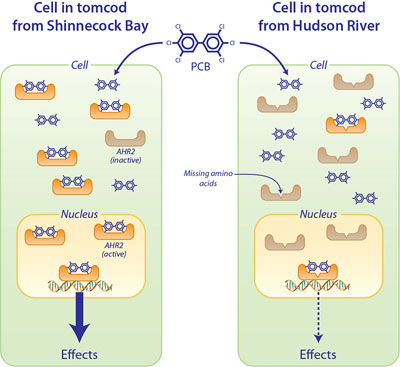
"We’ve found evolutionary change going on very quickly due to toxic exposure, and just one gene is responsible for it," stated Isaac Wirgin, a population geneticist, associate professor of environmental medicine at NYU School of Medicine and leader of the study. "There are not many examples of this in the scientific literature."
Tomcod from the Hudson River have a variant protein that makes them less sensitive to the toxic effects of PCBs. The effects of PCBs occur through their interaction with a protein called Aryl Hydrocarbon Receptor 2 (AHR2). AHR2 is normally inactive, but when PCB molecules bind to it, AHR2 becomes activated and acts as a molecular switch to turn on other genes that lead to toxicity (Effects in the figure). Tomcod such as those from Shinnecock Bay, Long Island, NY (left panel) have a normal version of the AHR2 protein, which has a high affinity for PCBs. Tomcod from the Hudson River (right panel) have a variant AHR2 protein that is missing two amino acids (building blocks of proteins). Without these two amino acids, the AHR2 from Hudson River fish has a reduced ability to bind PCBs as compared to the normal AHR2 protein. This makes the Hudson River fish less sensitive to the effects of PCBs. (Illustration by Jack Cook, Woods Hole Oceanographic Institution)
From 1947 to 1976, General Electric poured some 1.3 million lb of PCBs into the Hudson River, where Atlantic tomcod is a common bottom-feeding fish not normally used for human consumption. It has been observed for a long time that the fish survives exposure to the toxic chemicals, and their levels are some of the highest reported in wildlife.
Yet, how tomcod could survive living amid concentrated PCBs instead of dying off like other species had remained inscrutable.
Wirgin and other researchers working at the National Oceanic and Atmospheric Administrations (NOAA) Fisheries Service (NMFS) and the Woods Hole Oceanographic Institution (WHOI) collected tomcod for four years from both polluted and relatively uncontaminated areas of the Hudson River in the winter, during the fishs spawning season. The tomcod were then screened for genetic variants in a gene – the aryl hydrocarbon receptor2 (AHR2) – encoding a protein that regulates PCBs toxic effects.
The study found that small alterations in the gene appear to shield the fish from PCBs.
Because tomcod from cleaner waters were found to occasionally possess mutant AHR2, these variants might have existed in minor proportions before PCBs were introduced into the Hudson River, Wirgin told. The fish would then have had an advantage over other species that suffered lethal heart defects in juveniles when the PCBs were released into their environment.
This advantage may have caused genetic changes in tomcod over some 50 years, the findings suggest.
Mark Hahn works in lab with colleague Diana Franks.(Tom Kleindinst, WHOI)
"We think of evolution as something that happens over thousands of generations," noted Wirgin. "But here it happened remarkably quickly."
The bad news is that, in exchange for the protection against PCBs, the fish are probably experiencing slower growth or lower resistance to other environmental stresses, Discovery reports.
And notably, the tomcod are allowing PCBs to penetrate the food chain.
"They serve as a prime prey for striped bass," Wirgin said. "You’ve got this fish that would normally be dead from PCBs or dioxin. It’s alive and it’s carrying around all this PCB and dioxin and it gets eaten."
By Natalia Real
editorial@fis.com
www.fis.com
Sport Fishing Forums – Offshore Big Game Fishing News Click Here
——-
February 18, 2011 Lahaina Harbor, Maui
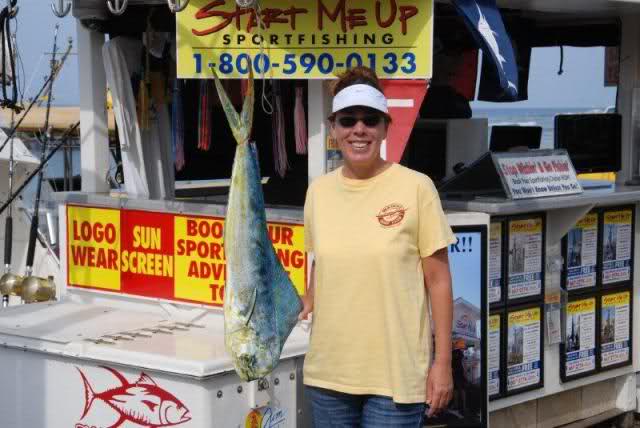
Tammy McCaluso took some time off from the beach on Valentines Day to go fishing. Tammy was compensated for her sacrifice of beach time in the form of a mahi. Besides, boats are just as good as the beach when it comes to working on a tan.
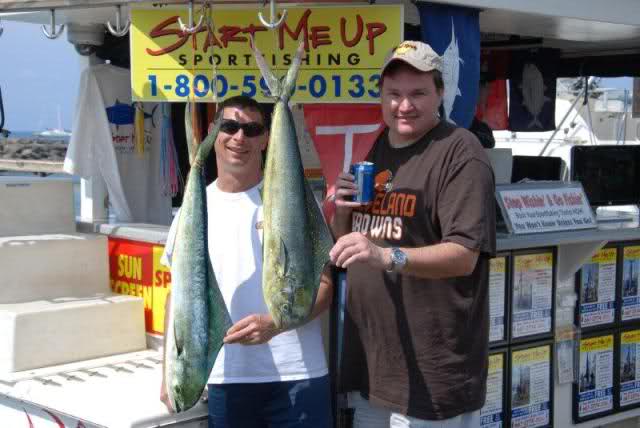
Joel Davidson and Todd Benge went two for two on mahis at the shoals of Kahoolawe. The shoals have been a hot spot for several weeks now.

Allan Housh was delighted to catch this mahi on a nine inch jet while trolling. Allan carpooled to the harbor with a fellow fisherman and was thrilled to get out on the water. Catching such a nice cow mahi was just icing on the cake.

Mike Schaat caught a huge bull mahi that weighed in at a hefty 47 lbs. on Start Me Ups early trip. A specimen of that quality is a real treat to catch since large mahis are incredibly strong and can probably rival any fish in the ocean pound for pound.
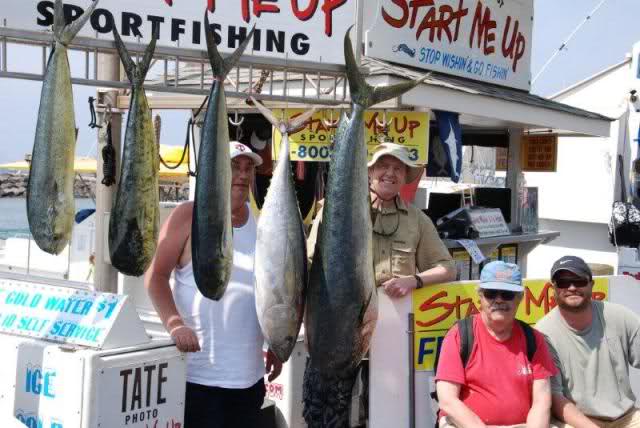
The big bull mahi was only part the early trips catch. Mike, Steve Fagerness, Pat Mauer, and Dave Newton combined for a total of four mahis and a nice shibi. Steves shibi weighed in at 40 lbs. as the tunas around the buoys are slowly creeping up the scales.
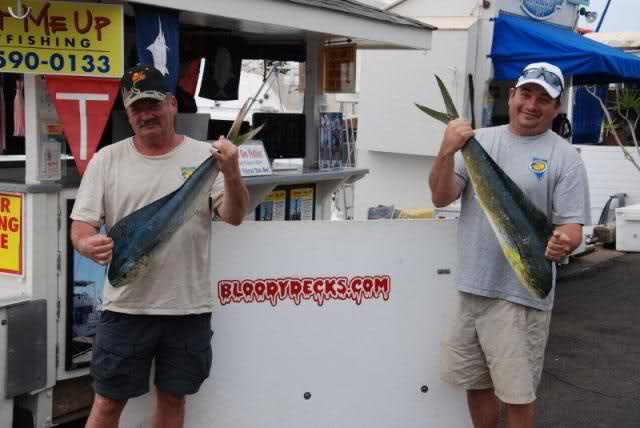
Allan and Darren Martin caught these two mahis while skirting the island of Lanai along the 150 fathom ledge.
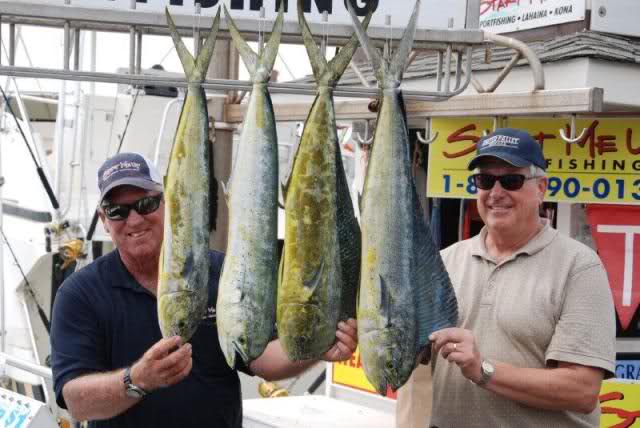
Wayne Randall fished all by himself and had a very pleasant day on the water. Waynes four mahis came on a combination of bait and lures and at the end of the day when the action was all over, he posed for a picture with his captain.

Tom Hogan and a good friend went out for a short trip. Their short trip, however, was long enough for them to come back to the harbor with dinner.
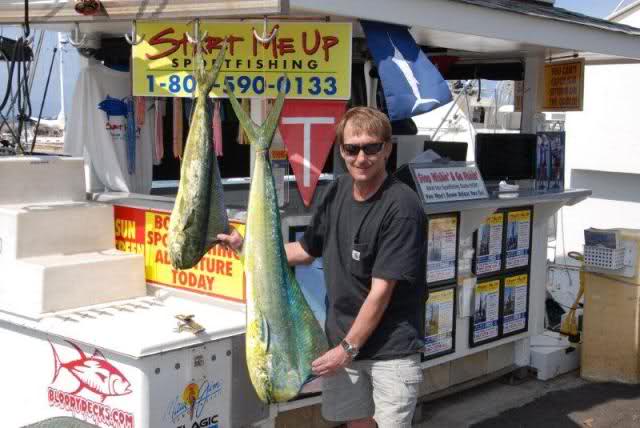
Mark Taylor caught a couple of mahis while trolling the deep water for marlin. He described the trip as one of the higher quality charters he has been on, a compliment that the crew surely appreciated.
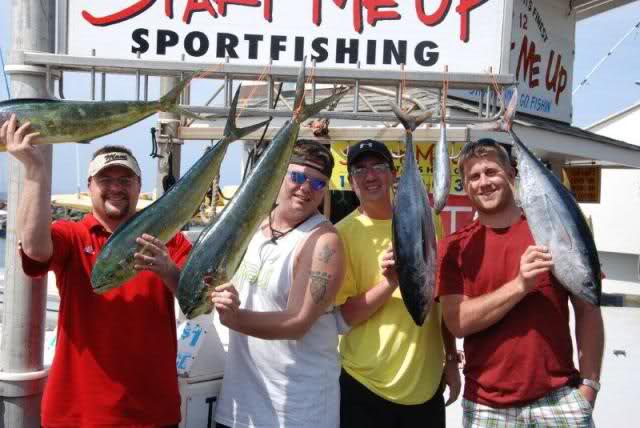
Nebraskas Jim Edmonds, Kevin Keegan, Jeff Pieper, and Bill Winberg had a good time fishing in Maui county. They actually trolled behind Lanai, where they landed three mahis and two shibis.
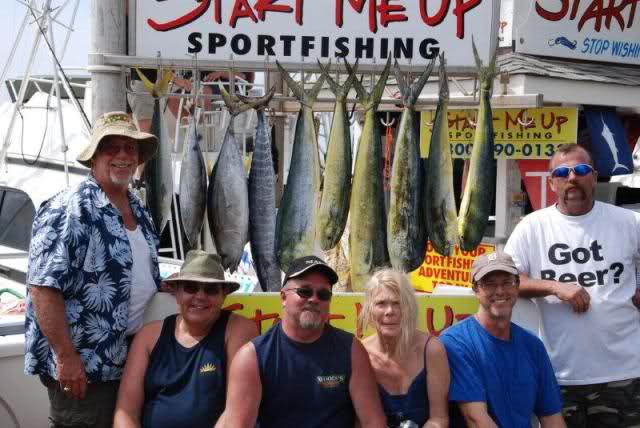
Some guys go fishing just to get away from their wives. Gary Reep, on the other hand, fished with his wife and having lady luck onboard paid off big time. Gary and his wife were joined by fellow anglers Ron Okon, Jerry Wieddenhoff, Gary Lacen, and Mike Cannon. Together, the group reeled in a mixed bag of fish off a very productive floater. Their total catch ended up being six mahis, two shibis, a rare winter ono, and a rainbow runner or kamanu.
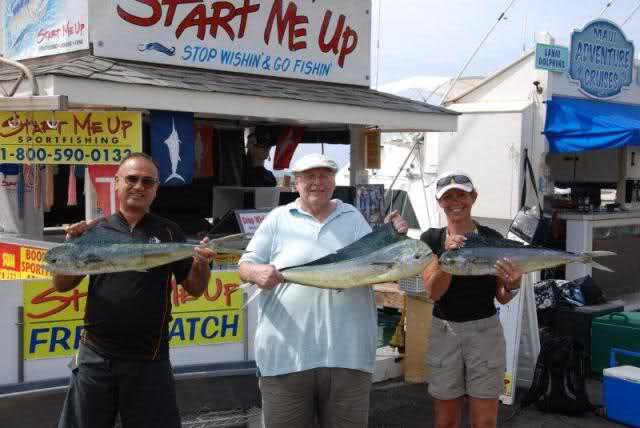
Anglers Hidal Alabedi, Doug Yeomans, and Dody Hawthorne, who fishes regularly with Start Me Up when visiting Maui, each caught a mahi. This group had a perfect record for the day, getting three bites and catching all three fish.
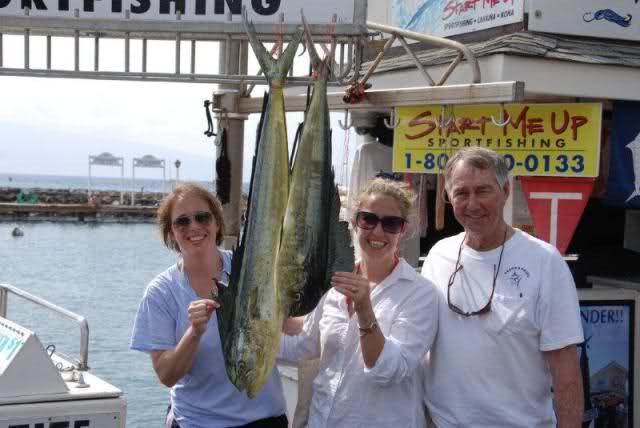
Robert Goff and his daughters Sissy and Kathleen made fishing a family affair and caught two mahis. They said that fishing is a great way to spend quality time together.
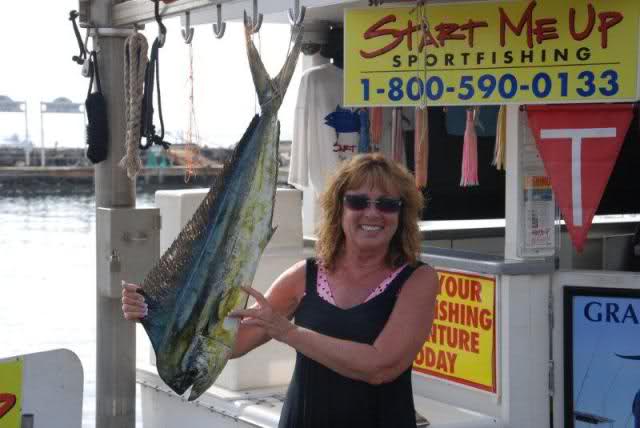
Diane Halass did an afternoon trip and could not have imagined having a better time. She was excited about catching her mahi and, as an added bonus, was able to see many humpback whales, which migrate to Hawaii in the winter. Diane said that she would recommend fishing to anyone.

Malcolm Scott spent a few hours fishing and was lucky enough to find a mahi right in front of Lahaina town. This mahi retained some of its color despite being chilled on ice.
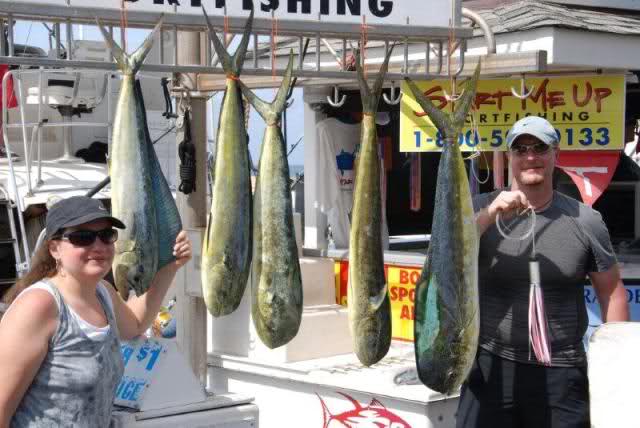
Barb and Chris Tomei had a busy day, catching five mahis and missing a blue marlin. Chris is displaying the lure that drew the marlin strike. Even though the marlin could have been hooked better, the strike certainly caused Chris and Barb to get hooked on big game sportfishing.
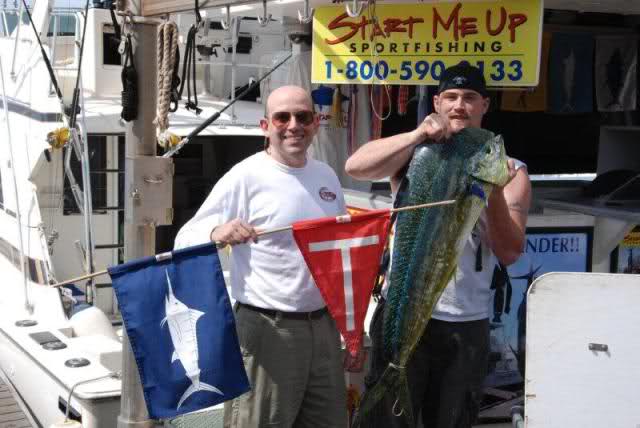
Adam Lichtmans day involved a catch and release while Dennis Lavique chose to catch and consume his mahi. Adam released a striped marlin, which have been attacking trolled lures as of late.
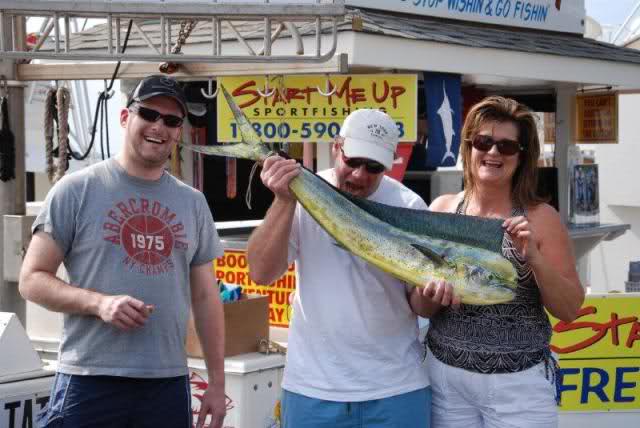
Denise and John Kasper, along with their son Adrian, caught this mahi off an inshore pinnacle during their afternoon trip. John was unable to contain his enthusiasm at the prospect of eating some mahi.
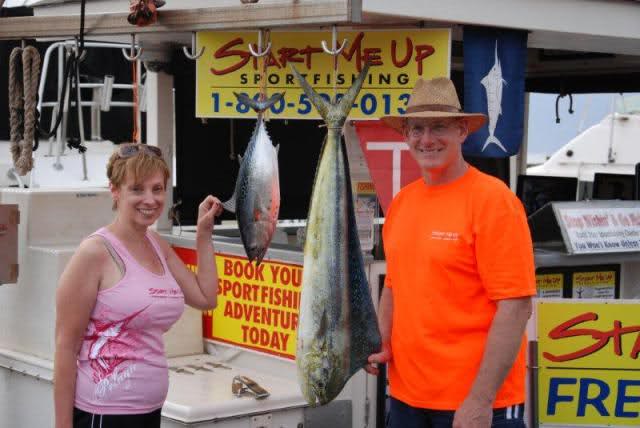
Chuck and Sue Lee went out on their afternoon trip decked out in Start Me Up gear and came back with a mahi and a kawa kawa. They were glad to get fresh mahi steaks for their thirtieth wedding anniversary since that quality of seafood is hard to come by back home in Middletown, New York.

Jeff Wilkensons first trip to Maui from Canada ended well with this mahi. The mahi was caught on a trolled lure near sweetheart rock, which is at Manele bay on Lanai.
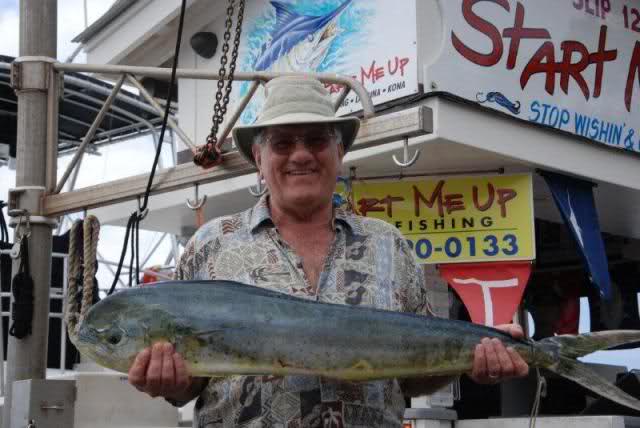
Angler Al Giesbrecht hooked his mahi while trolling off Manele. Als mahi was one of the two caught in the Manele bay area.
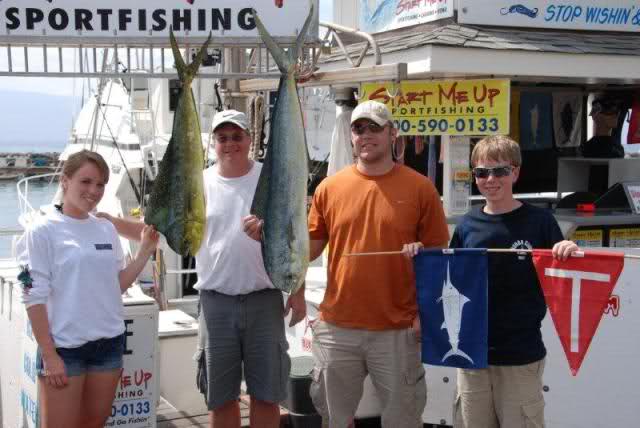
Anglers Kolten Kantterud and Colter, Lauren, and Clay Christian had a good day on the water. Kolten and Lauren each boated a mahi and Colter caught and released a striped marlin. Releasing marlin is always nice when the mahis cooperate and provide some food for the dinner table.
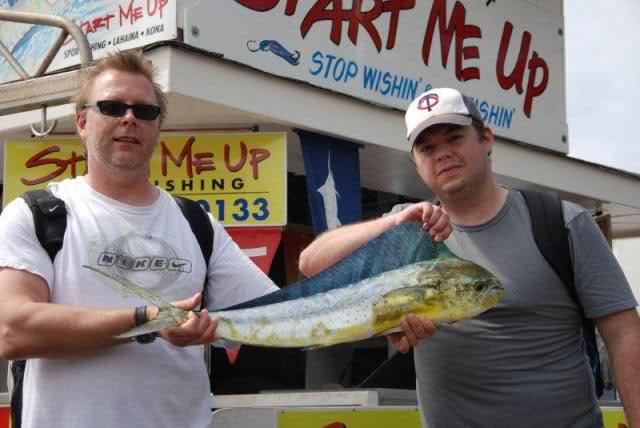
This mahi was picked up in the final minutes of the trip, serving as yet another example of the fact that the fishing is never over until the last hook is out of the water. Knut Dahmann was the lucky angler.
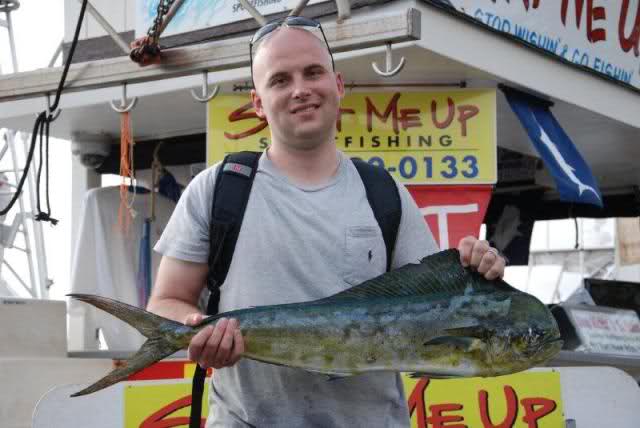
Scott Peeler, an Alabama native, boated his first Maui mahi mahi while trolling in the vicinity of LA buoy.

Roy and Deloris McMurren, Scott and Todd Barrett, Dick Posthumus, and Jerry Veldhuis had a catch of mahis and tunas. They found the fish at N buoy on the north shore of Molokai.
Thanks for checking out another Start Me Up fishing report. Our next report will probably be up within a week. For anyone who wants a report in the meantime, call Deli or myself at 808-667-7879 between 9 a.m. and 5 p.m. Hawaii time or email startmeupfish@gmail.com. Thanks again for taking a look. Tight lines.
Aloha,
Jonny
Sport Fishing Forums – Offshore Big Game Fishing News Click Here
——-
How do you pull a Blue Marlin spread
Sport Fishing Forums – Offshore Big Game Fishing News Click Here
——-
44066/TT4 Summer 2011 Anticipated Replacement– NDBC Photos and Story Follow
The NDBC is responsible for the design, building, deployment and maintenance of all the weather, tsunami and DART buoys all along the coast of the United States and other areas around the world. Housed in the Stennis Space Center, former testbed for early Saturn and Ajax spacecraft jet engines, this campus has an unusual history. This area was the home of Werner Von Braun who ushered in the space age rocket engine at this location. Now the sprawling campus of buildings houses a variety of NOAA agencies. Occasionally a new jet engine is tested in the nearby areas creating unannounced blasts that rock the seats of unsuspecting engineers and administrators.
The NDBC is a 24/7 facility. Every buoy under their control is monitored regularly to guage consistency and correct transmission of data. Meteorologists use large colorful plasma screens to watch the weather conditions throughout the day while engineers work with remote on-water technicians to calibrate newly deployed buoys. In the work area, tens of enormous spools of different sized mooring line, chain and fittings are scattered about and new material is tested to improve mooring strength. Others grapple with large pre-fab payloads inserting them into the bellies of the buoys. An early failure of the 44066 was water that leaked from a topside cable slit that allowed the water to find its way into the payload disabling the water temp sensor. This facility is a beehive of activity.
Surprisingly it is not always the severe weather but ships that accidentally cut the lines setting buoys free. In the Pacific there is a big problem with tuna fishers tying off and actually cutting mooring lines to catch fish. This is an expensive and dangerous practice sacrificing safety for the local economy.
NDBC has redesigned the familiar weather buoy we know with a more modular
design making it more resistant to the harsh climates offshore. These will begin to be dropped into position this season. Director Portmann is committed to continue to provide important information from equipment designed to protect and save lives through a more innovative buoy type. In years to come they will begin to integrate unmanned gliders which will deliver atmospheric and oceanic data from circling water devices which will be lighter, and less expensive to deploy and service.
All the buoys are constructed in the high-ceiled building that formerly housed huge
jet engines. The buoys look tiny in these aeronautic caverns of the cold war era.
Buoys are assembled here and placed in the nearby man-made lagoon for testing. They are then laid out on buoy alley awaiting deployment by available Coast Guard vessels.
The CG vessels also provide maintenance. Normally the life span of these is 2-3 years when a service rotation replaces each buoy. They are looking for ways to speed up the process to reduce the rotation down time and keep our data flowing. Especially important for us is the operability of the other 44017 Montauk and 44025 Fire Island buoys.
Old buoys are refurbished and re-outfitted. One is flying saucer looking buoy which is similar to the now currently situated off Bermuda. It is so large you could have a clam bake party on this. Some, like the original Hotel buoy that used to be 250 miles off New jersey had broken off its mooring in 2009 and was eventually retrieved near Bermuda. It now sits near buoy alley gathering guano and rust. It will probably never see service again.
There has been a request in to the Coast Guard for the 44066/Texas Tower 4 buoy re-deployment for a month. Due to the BP Deepwater disaster some CG vessels are still catching up on previous work. According to the NDBC ops team they are expecting a summer mooring.
They understand the marine and angling need and are doing their best to get it scheduled.
When in Louisiana you might take the 75-minute ride to Stennis and visit the facility. You can get a chance to see your government at work engineering buoy data devices that make our fishing and boating journeys safer.
Macoora is the Mid Atlantic Coastal Ocean Observing Regional Association, one of 11 regions under IOOS. Attachment 187611Attachment 187612Attachment 187613Attachment 187614Attachment 187615
Sport Fishing Forums – Offshore Big Game Fishing News Click Here
——-
Iceland Cod Charter Recommendations? Late May
Any suggestions? Looks like they have an extremely healthy fishery and fish within 2-3 miles of the shore. They even catch them surf casting.
Sport Fishing Forums – Offshore Big Game Fishing News Click Here
——-





